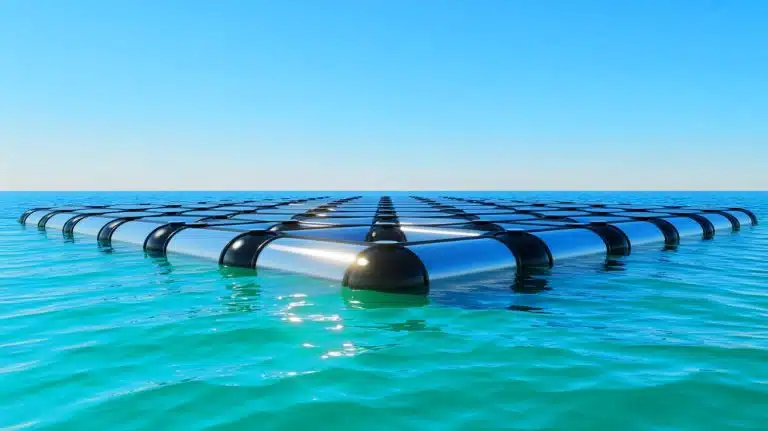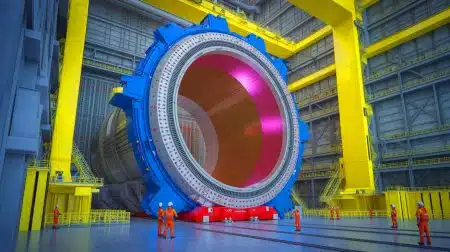| IN A NUTSHELL |
|
The vast oceans, often admired for their serenity, hold an untapped potential to illuminate our world. Harnessing the power of waves to generate electricity is not a novel concept, but Kinowave, an innovative wave energy system, has taken this idea to new heights. Recently crowned as a national winner at the prestigious James Dyson Award, Kinowave is paving the way for a cleaner energy future. This recognition marks a significant achievement for the wave energy sector, promising to transform how we perceive and utilize the ocean’s energy potential.
A Nature-Inspired Solution
Wave energy, also known as wave power, holds tremendous potential. However, its harnessing has traditionally been complex and costly. Conventional wave energy technologies often require permanent, expensive structures, making them less feasible and environmentally friendly. Kinowave, on the other hand, offers a streamlined alternative. Inspired by Pascal’s Law, a fundamental principle in physics, Kinowave employs a series of interconnected floating cylinders. These cylinders move with the waves, and as they rise and fall, the fluid inside shifts, creating kinetic energy. This ingenious approach simplifies the process and reduces the need for large, intrusive installations.
By utilizing this straightforward yet effective mechanism, Kinowave presents a more accessible solution to capturing wave energy. The design’s elegance lies in its simplicity, drawing inspiration from natural processes while minimizing environmental impact. This innovative approach not only addresses technical challenges but also opens up possibilities for broader adoption and implementation of wave energy systems worldwide.
Proven Efficiency and Dual Impact
The kinetic energy generated by the movement of the cylinders is converted into electricity using an ultra-efficient Wells turbine. This combination of smart design and cutting-edge technology enables Kinowave to achieve a conversion rate that surpasses most existing wave energy generators. Beyond energy production, Kinowave addresses another pressing issue: coastal erosion. By capturing up to 65% of wave energy, the system reduces the destructive force of waves hitting the shoreline, offering a dual benefit of clean energy production and coastal protection.
Coastal erosion poses a significant threat to communities and infrastructure worldwide. By mitigating this impact, Kinowave provides a holistic solution that enhances the resilience of coastal areas. The dual functionality of energy generation and coastal safeguarding not only makes Kinowave a valuable asset but also highlights its potential to address multiple environmental challenges concurrently. This dual approach underscores the system's versatility and its potential to make a significant contribution to sustainable development.
Kinowave's Vision for the Future
The journey of Kinowave is just beginning. Having successfully validated their concept with a small-scale prototype, the team is now planning to develop a 100 W prototype, aiming to eventually scale up to 10 kW to power multiple households. Their long-term vision includes deploying Kinowave systems in real oceanic conditions and offering modular solutions for coastal communities. This ambition reflects the team's confidence in the transformative impact of their technology.
One of Kinowave's boldest goals is to collaborate with the government of the Seychelles to test the system in real-world conditions. This partnership aims to demonstrate the system's effectiveness and scalability. The recognition from various innovation contests, coupled with the James Dyson Award, adds credibility to their mission. As Kinowave continues to evolve, it holds the promise of reshaping the renewable energy landscape by making clean, wave-generated electricity a viable option for communities around the globe.
Challenges and Opportunities Ahead
Like any pioneering technology, Kinowave faces challenges that must be addressed to achieve widespread adoption. These include ensuring the durability of the system in harsh marine environments and securing funding for large-scale deployment. However, the potential rewards are immense. By providing a sustainable source of energy and protecting vulnerable coastlines, Kinowave presents a compelling case for investment and support.
The success of Kinowave could catalyze further advancements in wave energy technology, encouraging other innovators to explore nature-inspired solutions. As the world seeks to transition to renewable energy sources, wave energy systems like Kinowave offer a promising path forward. The question remains: how will policymakers, investors, and communities respond to this opportunity to harness the ocean's power for a sustainable future?
As Kinowave continues to develop and test its system, the potential for wave energy to contribute significantly to the global energy mix becomes increasingly apparent. What role will wave energy play in shaping our renewable future, and how can we best support innovative solutions like Kinowave in achieving their full potential?
Did you like it? 4.5/5 (22)







Wow, 65% efficiency! That’s incredible! How soon can we expect to see this tech powering homes? 🌊⚡
How does Kinowave’s technology compare to traditional wave energy systems? 🌊
65% efficiency sounds impressive! How soon can we expect to see this widely implemented?
Is this system safe for marine life? I hope it doesn’t disrupt the ocean’s ecosystem. 🌍
What happens to marine life with these floating cylinders? 🐟
Finally, a solution that tackles energy and coastal erosion—two birds, one stone! 🕊️
Can it withstand severe storms or tsunamis? 🤔
I’m curious about the cost. Is it affordable for coastal communities?
Can this be used in all oceans, or are there specific conditions it needs to work effectively?
Sounds too good to be true. What’s the catch? 🤨
Sounds promising, but what about the maintenance costs? Can it withstand storms?
Finally, a solution that fights coastal erosion while generating power! Bravo!
I love the idea of wave energy but “steals” 65% of wave energy forever? Sounds a bit dramatic. 😄
Great idea! Hope it doesn’t harm the ocean ecosystem. 🌍
Are there any plans to test this outside the Seychelles?
How long does it take to install a Kinowave system?
Impressive work! Thanks for making the world greener! 💚
What kind of maintenance does this system require?
65% of wave energy is amazing! How did they measure that?
Will this be available to individual homeowners or just large communities?
How does Kinowave handle variable wave conditions?
Excited to see innovation in wave energy! 🌊
Can this tech be adapted for freshwater bodies like lakes?
Great concept, but what about the initial investment costs? 💸
Is this system completely renewable or are there any hidden downsides?
I’ve always wondered why we don’t use wave energy more. Go Kinowave!
What materials are used in these floating cylinders? 🌐
Imagine a world where my beach house is powered by the ocean! 😄
What are the potential environmental impacts on marine life?
Can it be scaled to power larger urban areas?
Hope this doesn’t end up as another failed energy experiment. 😅
How will this affect local fishermen? 🎣
Finally, a dual-benefit technology! Keep up the great work!
Will this technology work in all ocean conditions?
How reliable is the electricity supply from Kinowave during calm seas?
Thank you for working towards a sustainable future! 🌟
Can Kinowave systems be combined with other renewable energies?
How does this interact with existing marine infrastructure?
Is wave energy the future of renewable energy? 🌊
How do you plan to get investment for large-scale deployment? 🤔